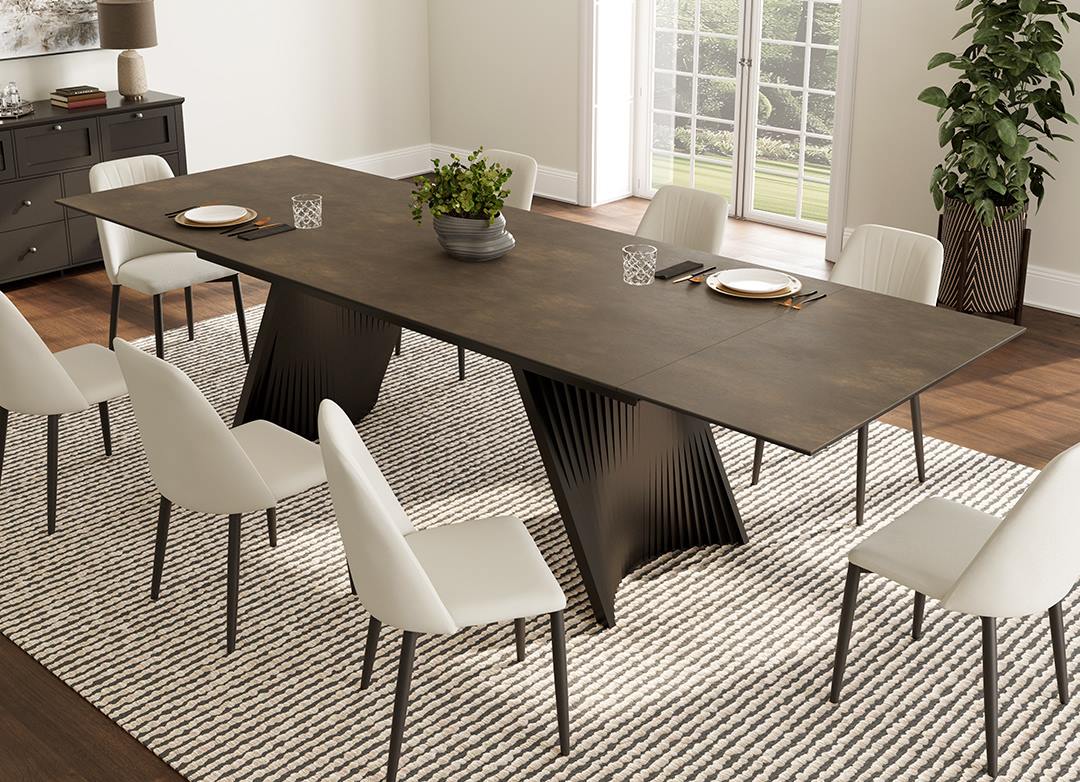
Buying Guide: How to Choose the Right Dining Table
|
|
A dining table is more than just a place to eat, it’s the heart of the home, where conversations unfold and memories are made. With countless styles, materials, and sizes to choose from, finding the right one can feel like a challenge.
We’ve broken it down and created a guide to help you choose a table that fits your space, suits your lifestyle, and complements your design vision.
Table of Contents
The first step in choosing a dining table is knowing how much space you have and how many people you'll need to seat comfortably. A table that’s too large can crowd the room, while one that’s too small might feel underwhelming.
Small tables (36–48 inches in diameter): Seats up to 4 people, great for compact dining rooms or kitchen corners.
Medium tables (48–72 inches in length): Seats 6–8 people, ideal for standard-sized dining areas.
Space Planning Tips:
Pro Tip: Use painter's tape to mark out the dimensions of a table before buying—it helps visualize scale in your space.
The material of your table affects its durability, maintenance, and overall look. Here are three popular choices:
Elegant and timeless, marble tables make a statement. They're easy to wipe clean but require care to avoid scratching or staining.
Highly resistant to heat, scratches, and stains. This low-maintenance option offers sleek, modern style with serious durability.
Materials like oak, walnut, or ash offer warmth, natural grain, and longevity. Wood tables require regular maintenance but age beautifully.
Maintenance Tip: Be aware of what your chosen material requires. For example, marble may need resealing, and wood benefits from oiling to preserve its finish. Proper upkeep will ensure your table remains a stunning centerpiece for years to come.
The shape of your dining table plays a key role in both how your space feels and how people interact around it. Here's a quick guide to help you choose the right one for your home:
Round Tables:
Perfect for smaller dining areas, round tables encourage conversation and offer a family-friendly option with no sharp corners—especially great for homes with young children.
Tip: For larger round tables (60–72 inches), a lazy Susan can make sharing dishes easier and more convenient.
Rectangular Tables:
The most traditional shape, which is great for longer rooms and larger groups. They can accommodate for more seating, making them ideal for large families or frequent get-togethers.
Oval Tables:
A softer alternative to rectangular tables, oval designs offer the same seating capacity with a more fluid silhouette.
Tight on space? Foldable or extendable tables offer flexibility without sacrificing style.
Extendable tables are ideal for flexible hosting—expand when you need extra seats for guests, then scale back for everyday use.
Built-in storage adds hidden convenience, offering space to stash tableware or linens, perfect for keeping dining areas neat and organized.
Choosing a multifunctional design adds value to your space and supports how you live day-to-day.
From material to silhouette, the dining table you choose says a lot about your space and how you live in it.
Mid-Century Modern:
Defined by clean lines, organic curves, and warm materials, this style often features natural wood finishes like walnut paired with rich, earthy tones for a retro-inspired yet timeless look.
Modern:
Rooted in minimalism, modern style favors sleek materials like metal, glass, or stone. A palette of black, white, and matte gray keeps the look clean, sharp, and effortlessly contemporary.
Featuring dark solid wood with ornate carvings, this style offers a classic, elegant look. Popular color choices include rich tones like brown and deep red.
Regularly clean with a soft, damp cloth.
Avoid placing hot or wet items directly on the surface.
Use coasters, placemats, and tablecloths to protect the finish.
Apply the appropriate polish or oil for wooden tables.
Keep away from direct sunlight to prevent fading.
At Eureka Ergonomic, we believe great design is about more than looks—it’s about supporting how you live, gather, and connect. Our dining tables are thoughtfully crafted with durable materials, versatile functionality, and balanced proportions to elevate your everyday experience.
Explore our collection and find the dining table that fits your style and your space.
The right size depends on the number of people you typically seat and the space in your dining room. A 48-inch table is ideal for 4-6 people, 72 inches for 6-8 people, and 92 inches for 8-10 people. Make sure to leave at least 36 inches of space around the table for comfortable movement.
It depends on your style and lifestyle. Solid wood tables like walnut or oak are durable and classic. Marble offers a luxurious touch, while sintered stone provides a modern, durable option. Consider ease of maintenance and daily usage when choosing materials.
Yes! Extendable tables are perfect if you need flexibility. They’re ideal for everyday use but can expand to accommodate guests for gatherings or special occasions.
Rectangular tables are great for long, narrow rooms, while round tables work well in smaller spaces, promoting conversation. Oval tables combine the benefits of both, offering a softer look while fitting in narrow areas.



